The global pigmentation disorders treatment market is estimated to be valued at USD 8.01 Bn in 2025 and is expected to reach USD 14.94 Bn by 2032, exhibiting a compound annual growth rate (CAGR) of 9.3% from 2025 to 2032.
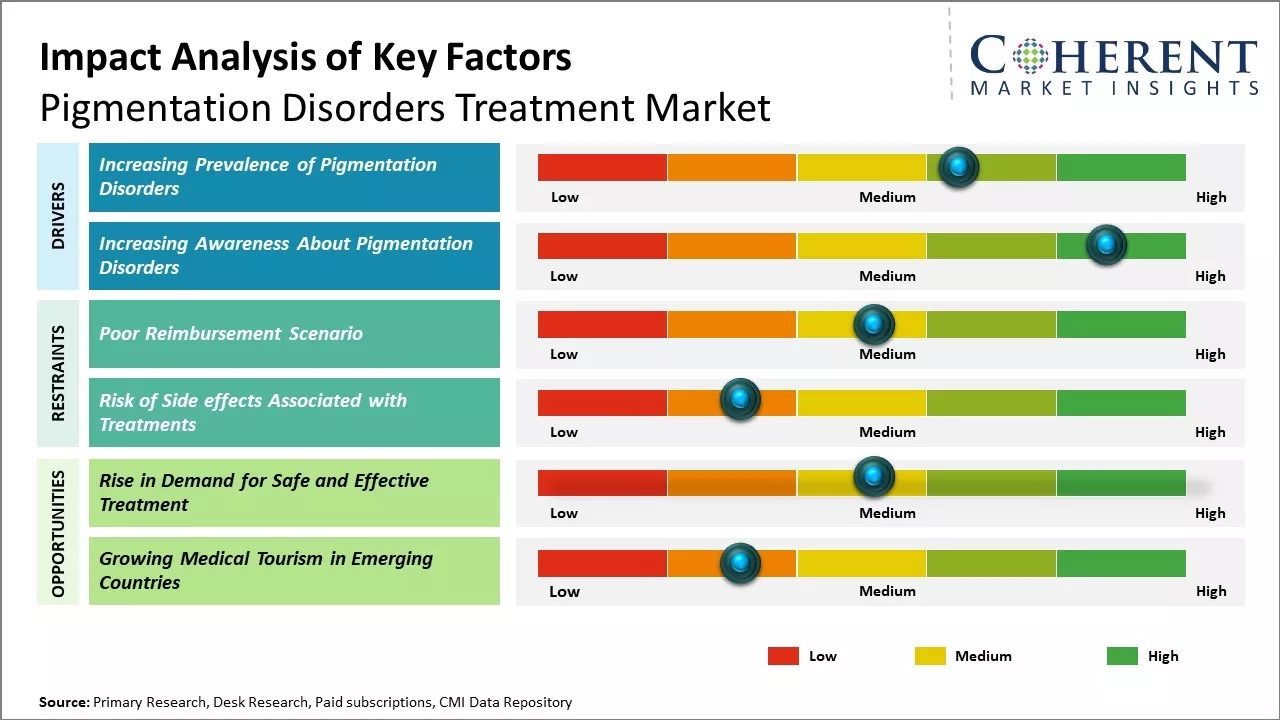
Discover market dynamics shaping the industry: Request sample copy
The global pigmentation disorders treatment market is experiencing strong growth due to the rise in prevalence of pigmentation disorders and growing geriatric population across the world. Moreover, rise in demand for safe & effective treatment and increasing awareness among people about pigmentation disorders is expected to boost the growth of the market. However, factors such as high cost associated with treatment and lack of reimbursement policies are expected to hamper growth of the global pigmentation disorders treatment market.
Market Driver – Increasing Prevalence of Pigmentation Disorders
The increasing prevalence of pigmentation disorders such as vitiligo across the globe is expected to augment the growth of the global pigmentation disorders treatment market over the forecast period. For instance, according to an article published in JAMA Network, an open access medical journal published by the American Medical Association, in November 2021, a survey was conducted on people living in the U.S. in 2020, and the study demonstrated that the prevalence of vitiligo in adults was between 0.76% (1.9 million cases in 2020) and 1.11% (2.8 million cases in 2020). Additionally, according to the same source, around 40% of adult vitiligo in the U.S. may be undiagnosed.
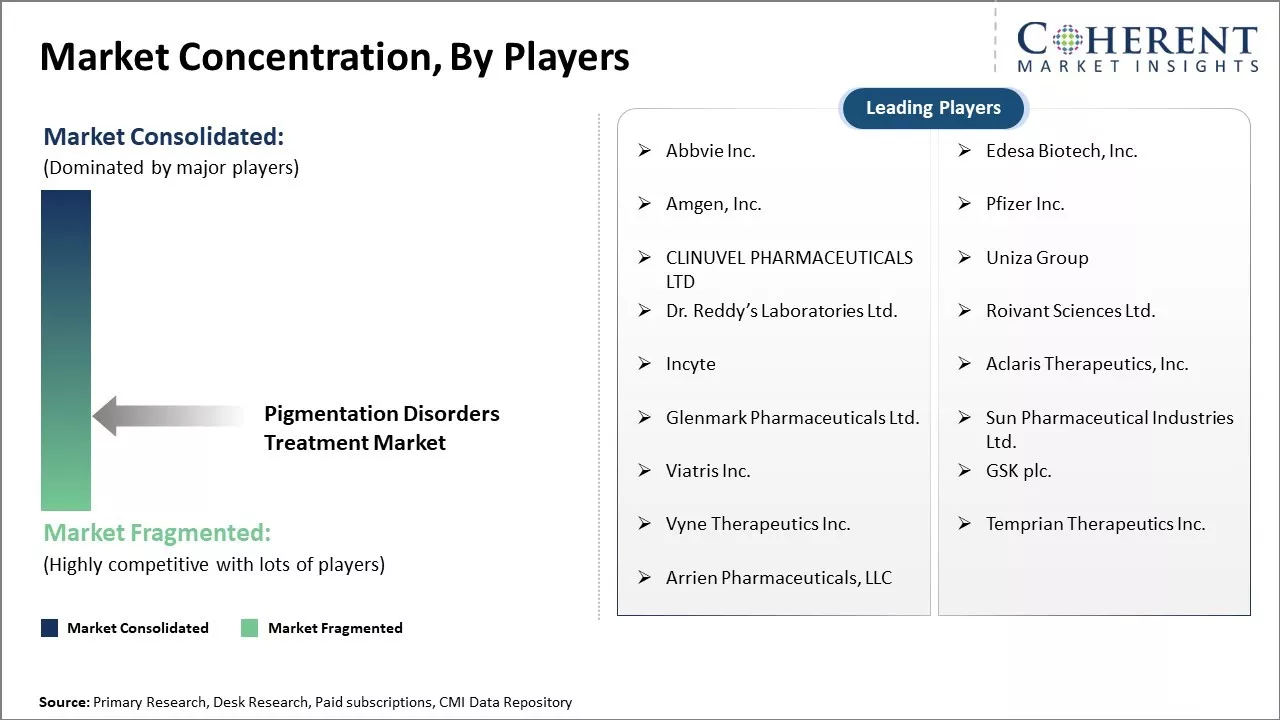
Get actionable strategies to beat competition: Request sample copy
Market Driver – Increasing Awareness About Pigmentation DisordersWith the increasing usage of social media and digital mediums, awareness about various skin conditions including pigmentation disorders has grown tremendously over the past decade. There is a rising knowledge amongst people about various skin conditions leading to uneven skin tone and patches. Various international non-profit organizations like International Dermatology Foundation and Melanoma Research Alliance are actively working to educate people on identifying signs of pigmentation disorders and encouraging them to seek medical guidance without any hesitation. Their efforts on social media and online awareness campaigns are helping remove the stigma around such skin conditions and normalize discussing them. This is allowing more individuals suffering from pigmentation issues like melasma, vitiligo or post inflammatory hyperpigmentation to openly consult doctors without fear. As a result, demand for topical creams, laser therapies and other treatment options available is surging across global markets. As per UN World Population Prospects report, nearly 1.7 billion people accessed internet worldwide by 2023, up from 3.2 billion in 2015. This points towards rising scope of virtual awareness drives impacting treatment-seeking behavior positively.
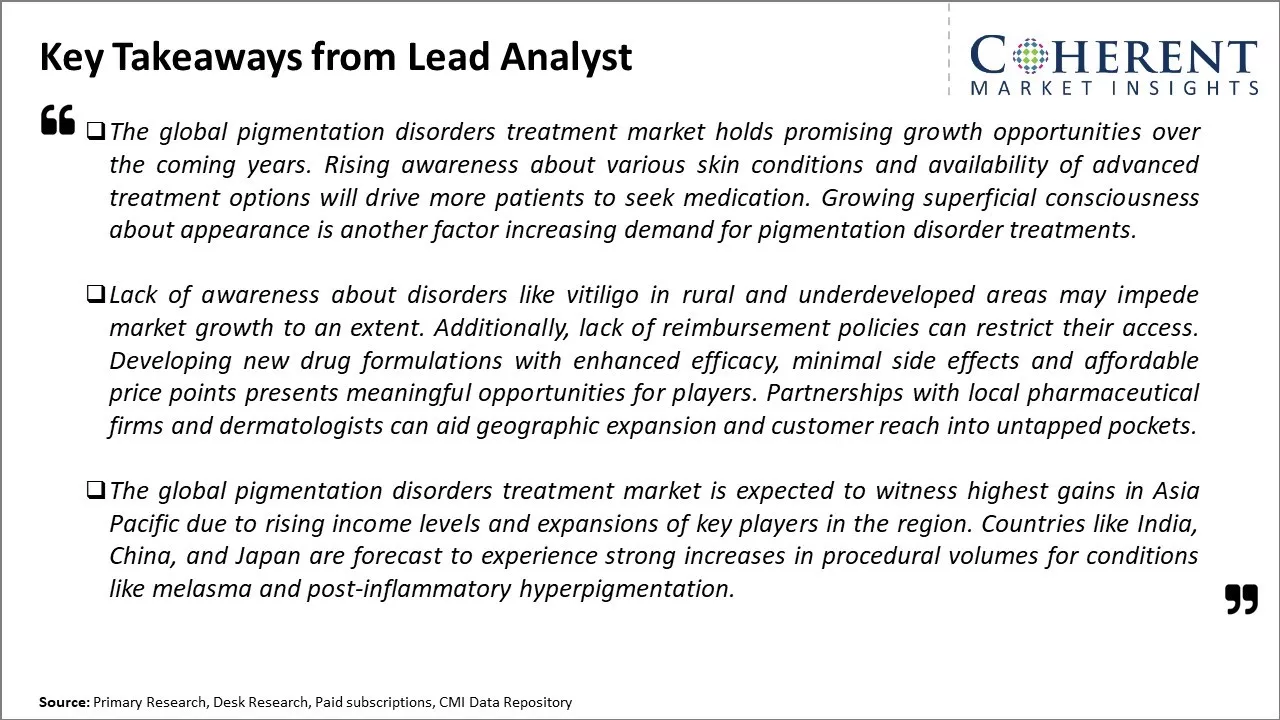
To learn more about this report, Request sample copy
Market Challenges – Lack of Reimbursement PoliciesLack of reimbursement policies is expected to hinder growth of the global pigmentation disorders treatment market. For instance, reimbursement is provided for medical expenses and treatment, but in the case of pigmentation disorders and its treatments, it is not covered under any policy. Insurance companies rarely cover these procedures, owing to which the patient has to pay out of pocket. The lack of reimbursement policies poses a challenge to the market.
Market Opportunities – Rise in Demand for Safe and Effective Treatment
Rise in demand for safe & effective treatment is expected to offer significant growth opportunities for players in the pigmentation disorders treatment market. For instance, in May 2022, CLINUVEL PHARMACEUTICALS LTD, a pharmaceutical company, announced that a new potential therapy for pigment loss disorder vitiligo will undergo further studies in North America. The drug afamelanotide, approved by the U.S. and European regulators for a rare light intolerance disorder, is being evaluated by CLINUVEL PHARMACEUTICALS LTD as a treatment for vitiligo patients with darker skin types.
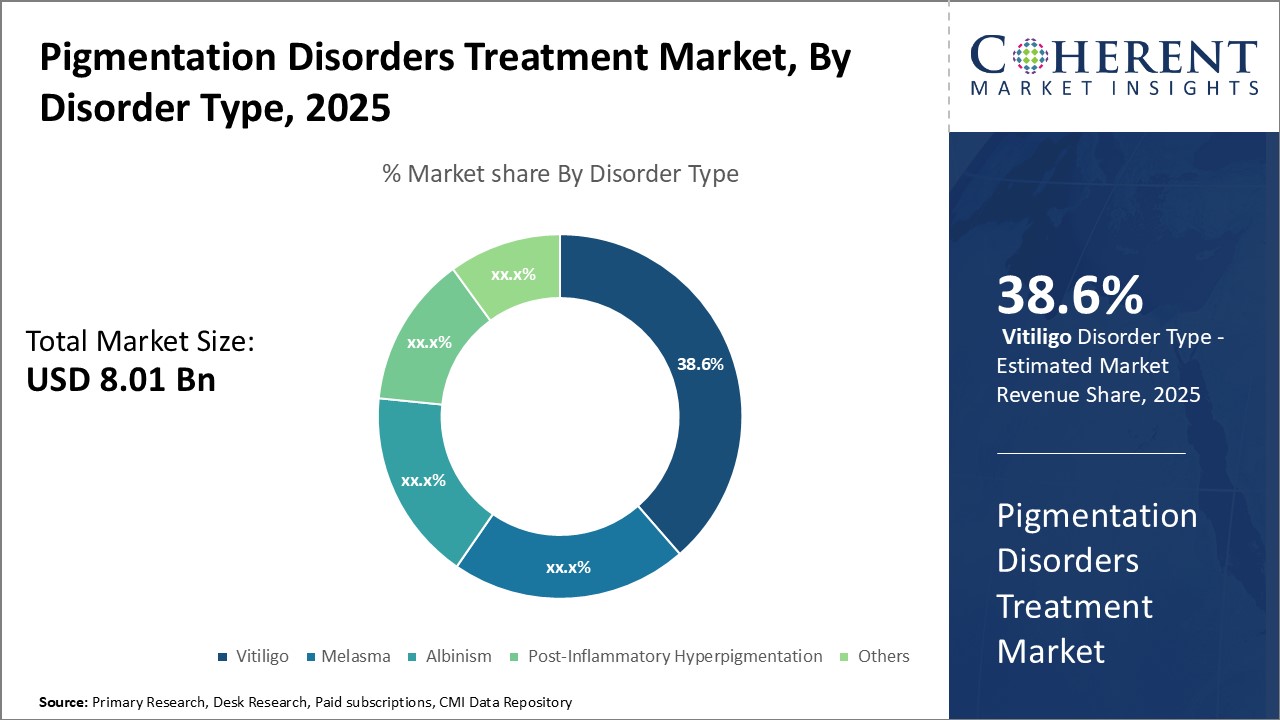
Discover high revenue pocket segments and roadmap to it: Request sample copy
Insights, By Disorder Type: Increasing Prevalence of VitiligoThe disorder type segment includes melasma, vitiligo, albinism, post-inflammatory hyperpigmentation (PIH), and others. The vitiligo lens sub-segment is estimated to hold 38.6% of the market share in 2025 owing to the increasing prevalence of vitiligo. For instance, according to the data provided by the Vitiligo Research Foundation in November 2021, in the U.S., an estimated prevalence of vitiligo was 1.11% of the population, including about 40% of those with the condition being undiagnosed in 2020.
Insights, By Drug Type: Increasing Preference of Corticosteroids for Pigmentation disorders
The drug type segment includes corticosteroids, calcineurin inhibitors, janus kinase (jak) inhibitor, melanin synthesis inhibitor, and others. The corticosteroids sub-segment is estimated to hold 35.9% of the market share in 2025 owing to the increasing preference of corticosteroids for the treatment of pigmentation disorders such as vitiligo. Topical steroids (corticosteroids) are the best option for people whose vitiligo patches do not involve the face and are considered first-choice treatment preferences for treating vitiligo. For instance, according to the website of Mayo Foundation for Medical Education and Research (MFMER), applying a corticosteroid cream to affected area helps in repigmentation of the skin. Corticosteroid cream is most effective when vitiligo is still in its early stages. This type of cream is effective and easy to use. However, side effects of these drugs such as skin thinning and appearance of streaks or lines on skin are expected to hinder the segment growth.
Insights, Distribution Channel: Increased Patient Visits to Hospitals
The distribution channel segment includes hospital pharmacies, retail pharmacies, and online pharmacies. The hospital pharmacies sub-segment is estimated to hold 46.4% of the market share in 2025 owing to increased patient visits to hospitals. For instance, according to an article published by the National Library of Medicine, in January 2022, there were around 1.9 million cases (diagnosed and undiagnosed combined) of vitiligo in the U.S. in 2020. Thus, the high prevalence of vitiligo is expected to drive demand for vitiligo drugs, which is expected to boost growth of the segment over the forecast period.
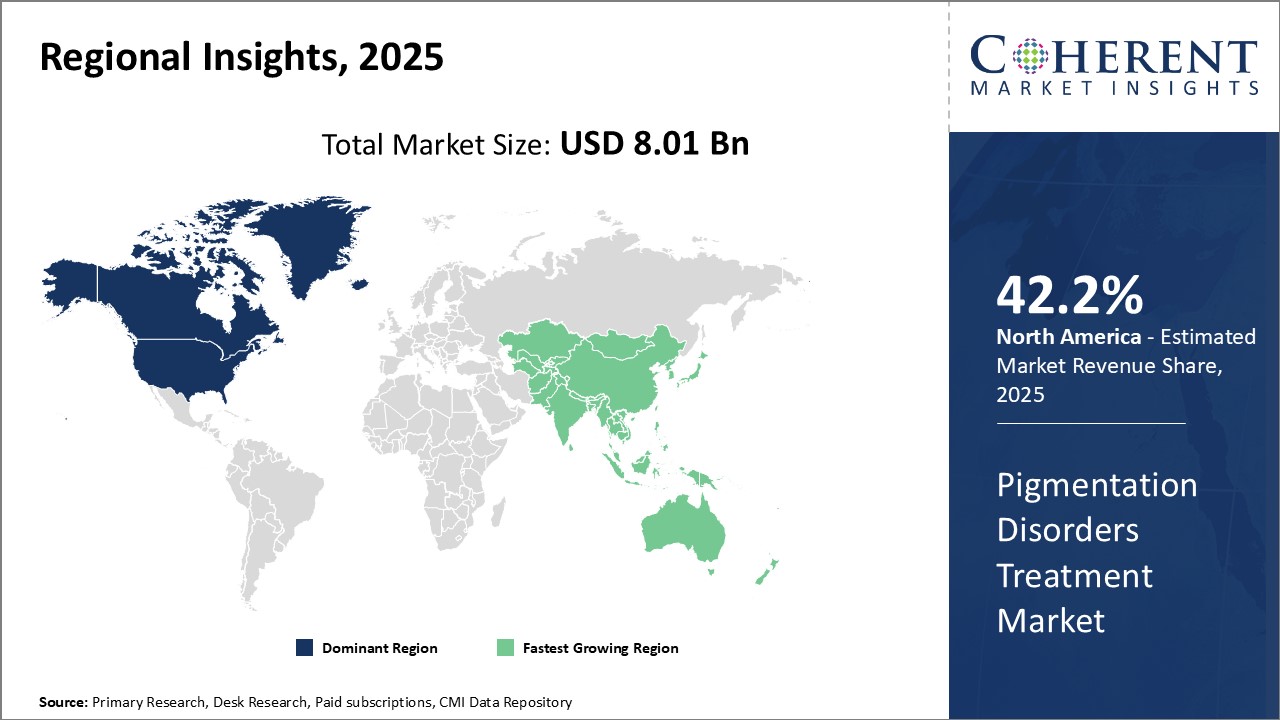
To learn more about this report, Request sample copy
North America remains the dominant region in the global pigmentation disorders treatment market and is estimated to hold 42.2% of the market share in 2025 due to the increasing prevalence of pigmentation disorders and growing geriatric population in the region. According to the U.S. Census Bureau (2022 report), over 56 million adults ages 65 and older live in the U.S., accounting for about 17.4% of the nation's population. By 2030, it is projected that there will be around 73.1 million older adults. This in turn is driving the market growth.
The Asia Pacific region has emerged as the fastest growing market due to the high prevalence of pigmentation disorders and rise in geriatric population in Asia Pacific region. As, pigmentation disorders more prevalent in the geriatric population. Asia Pacific is a home to some of the world's oldest population, those ages 65 and above. As per United Nations Economic and Social Commission for Asia and the Pacific (July 2022 report), there are 630 million people aged 60 years or over, representing 60 per cent of the world's older persons. By 2050, their number is projected to increase to 1.3 billion.
Pigmentation Disorders Treatment Market Report Coverage
| Report Coverage | Details | ||
|---|---|---|---|
| Base Year: | 2024 | Market Size in 2025: | USD 8.01 Bn |
| Historical Data for: | 2020 To 2024 | Forecast Period: | 2025 To 2032 |
| Forecast Period 2025 to 2032 CAGR: | 9.3% | 2032 Value Projection: | USD 14.94 Bn |
| Geographies covered: |
|
||
| Segments covered: |
|
||
| Companies covered: |
Abbvie Inc., Edesa Biotech, Inc., Amgen, Inc., Pfizer Inc., CLINUVEL PHARMACEUTICALS LTD, Uniza Group, Dr. Reddy’s Laboratories Ltd., Roivant Sciences Ltd., Incyte, Aclaris Therapeutics, Inc., Glenmark Pharmaceuticals Ltd., Sun Pharmaceutical Industries Ltd., Viatris Inc., GSK plc., Vyne Therapeutics Inc., Temprian Therapeutics Inc., and Arrien Pharmaceuticals, LLC |
||
| Growth Drivers: |
|
||
| Restraints & Challenges: |
|
||
Uncover macros and micros vetted on 75+ parameters: Get instant access to report
*Definition: Pigmentation is a skin condition caused by high quantities of melanin, a substance in the body that produces hair, eye, and skin pigmentation. Skin pigmentation disorders affect the color of the skin. Some common types of skin pigmentation disorders include albinism, melasma, vitiligo, and pigment changes from skin damage.
Share
Share
About Author
Ghanshyam Shrivastava - With over 20 years of experience in the management consulting and research, Ghanshyam Shrivastava serves as a Principal Consultant, bringing extensive expertise in biologics and biosimilars. His primary expertise lies in areas such as market entry and expansion strategy, competitive intelligence, and strategic transformation across diversified portfolio of various drugs used for different therapeutic category and APIs. He excels at identifying key challenges faced by clients and providing robust solutions to enhance their strategic decision-making capabilities. His comprehensive understanding of the market ensures valuable contributions to research reports and business decisions.
Ghanshyam is a sought-after speaker at industry conferences and contributes to various publications on pharma industry.
Missing comfort of reading report in your local language? Find your preferred language :
Transform your Strategy with Exclusive Trending Reports :
Frequently Asked Questions
Joining thousands of companies around the world committed to making the Excellent Business Solutions.
View All Our Clients